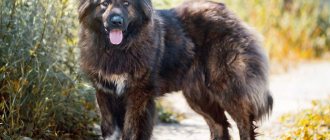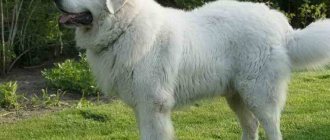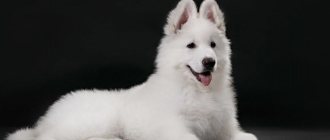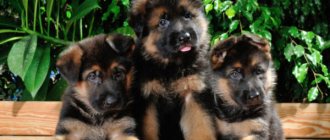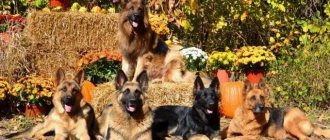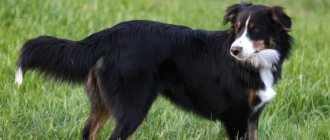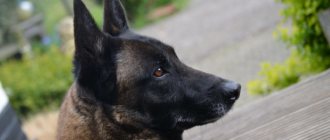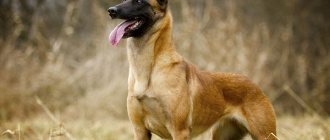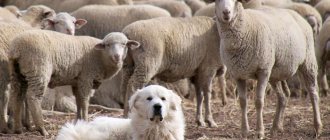Caucasian Shepherds are considered one of the largest dogs in the world, and their weight and size often exceed standard ones. The main thing that is required of the owner when raising and keeping a pet of this breed is to ensure that the weight and height of the animal are in the correct ratio and are not lower than the minimum standard limits.
Height and weight chart
| Age | Male weight (in kg) | Bitch weight (in kg) | Male height (in cm) | Bitch's height (in cm) |
| 1 month | 4-6,8 | 2,5-4,5 | 24-26 | 23-25 |
| 2 months | 13-19,6 | 11,5-18 | 34-37.5 cm | 33-35.5 cm |
| 3 months | 18-32 | 16,5-30 | 45-49 | 43-46 |
| 4 months | 25-60 | 22-50 | 51-55,5 | 48,5-51,5 |
| 5 months | 35-64 | 32-60 | 57-62,5 | 54-57 |
| 6 months | 40-94 | 35-92 | 63-68 | 59-63 |
| 7 months | 41,7-99 | 35,7-96,2 | 64-70 | 60-65 |
| 8 months | 43,4-104,4 | 36,5-100,6 | 65-72 | 61-67 |
| 9 months | 44,8-109,5 | 37,2-104,8 | 66-74 | 62-69 |
| 10 months | 46,2-114,6 | 38-109 | 66,5-75 | 63-70 |
| 11 months | 47,6-125 | 38,6-113,2 | 67,5-76 | 63,5-71 |
| 1 year | 50-125 | 40-115 | 68-78 | 64-72 |
Up to 2 weeks after birth
At birth, puppies weigh between 600 and 800 grams. If a baby weighs less than the minimum limit, then he is unlikely to be able to grow into a large dog with strong bones and voluminous muscles. But puppies weighing more than 800 grams can turn out to be problematic in terms of health and, moreover, significantly outgrow the standard.
Newborn babies are inactive: they sleep most of the time and eat very often. At the same time, their daily weight gain ranges from 113 to 200 grams.
By the age of two weeks, the body weight of puppies is 2000–3880 grams.
Keeping Caucasian Shepherd puppies
So, a funny and clumsy bundle of fluffy happiness, like a little bear, has appeared in your house - a Caucasian Shepherd puppy. And here the owners have many questions - what to feed the Caucasian Shepherd puppy, how many times a day, what kind of care does the baby need and what are the features of keeping representatives of this breed? Let's look at everything in order.
Caring for Caucasian Shepherd puppies
Before a Caucasian puppy appears in the house, it is necessary to prepare “housing” for the pet, the dimensions of which must correspond to the size of an adult dog. Of course, Caucasians do best in an enclosure, although dogs feel great in city apartments, but in this case it is very important to spend a lot of time walking with your pet. Sunlight and fresh air have a beneficial effect on the body and contribute to the proper development of the puppy.
The Caucasian Shepherd is a large and massive breed of dog, with well-developed bones and muscles, so owners should be prepared for frequent and long walks, even if the pet is kept in an enclosure. Walking and contact with other dogs is allowed 1.5 weeks after vaccination. You should introduce your pet to dogs carefully, avoiding contact with stray or aggressive animals. During a walk, the puppy should not be allowed to run after birds, cats, other dogs, vehicles, or show increased attention to strangers. Up to 2 months, puppies are walked on a leash, and from 5 months they are gradually accustomed to a muzzle.
When keeping in an enclosure, you need to properly arrange your pet’s “house” and divide it into several zones. Given the thick coat of Caucasians, to prevent the animals from suffering heatstroke, one part of the enclosure must be completely protected from the sun. The room in which the dog lives must be perfectly clean.
You cannot keep or leave a puppy for a long time in an unventilated, dark room, as this will lead to rickets and underdevelopment of the puppy. Until the age of 4 months, the baby should not be allowed to jump from high objects, and until the age of 3 months, the dog should be carried down the stairs to avoid “sagging” and curvature of the hind limbs.
From puppyhood, your pet is taught to care for its fur and ears. It is not recommended to bathe puppies until they are six months old. It is enough to wash your paws regularly and pay attention to the coat, brushing it at least 3 times a week. During the shedding period, coat care should be daily. You can bathe only if ectoparasites have appeared or the fur is very dirty, using only special shampoos for animals.
Many owners may encounter the fact that when the baby is left alone at home, he begins to chew on everything. whatever gets in his way. There is no point in scolding or even hitting a child. Make it clear in a fairly stern tone that such behavior is unacceptable. Dogs pick up intonation well, and next time you should definitely leave more toys so that the puppy has something to do in your absence.
Raising a Caucasian Shepherd puppy
From the first days of its appearance, it is very important to establish and establish contact with the dog, gain authority and begin training the dog. As soon as the adaptation period passes and the baby remembers his nickname, you need to start raising and training. Caucasian puppies that receive education and training at an early age grow up to be smart, obedient and balanced dogs with a stable psyche. A Caucasian must clearly know what is allowed to him and what is not. The puppy can be allowed to do everything that he will be allowed to do at an older age, since weaning him off bad habits will be much more difficult than immediately instilling the correct skills and manners of behavior.
Owners should be aware that the maturation process for Caucasians lasts up to 2 years, so in order to achieve complete obedience, it is necessary to be patient when training the puppy.
Raising and training a Caucasian Shepherd puppy should not be based on violence, screaming or the use of stun guns, as this will only embitter the dog and make it uncontrollable. At the age of 2-2.5 years, when the period of growing up is over, dogs begin to develop territorial behavior, interest in games decreases and the degree of mistrust increases, so it is very important to avoid mistakes when raising and training. You can train a Caucasian Shepherd puppy from the age of 2 months, starting with teaching the simplest commands. The basic commands that a Caucasian should know are “Come to me”, “No”, “Near”, “Place”, “Sit”, “Lie down”, “Stand”. Without sufficient experience, it is better to entrust the development of security skills to a dog handler. You can't force a puppy to do something he doesn't want to do. You need to achieve the execution of commands gradually but persistently. Starting from 3-4 months, little Caucasians should be gradually accustomed to swimming in clean waters. You cannot forcefully drag or throw your baby into the water, as this will lead to a fear of water in the future.
First month
Over the next two weeks, the shepherd pups begin to comprehend the world around them with the help of sight and hearing, and also gradually walk. By the thirtieth day of life, the height at the withers in boys of this breed is at least 24, and in girls it should be at least 23 cm. The weight of one-month-old puppies is 2500–6800 grams, while girls weigh less than their littermates.
3rd month
Outwardly, at this age, small shepherd dogs become similar to bear cubs. They are still clumsy, but their legs have noticeably elongated, and their heads and chest have become more voluminous.
At three months of age, daily weight gain is 200-400 grams.
By the third month of life, the puppy weighs 18-32 kg, and the height at the withers is 45-49 cm in boys and 43-46 cm in girls. From the age of three months, the shepherd dog begins to develop conditioned reflexes, and this is the time that is considered the most suitable to begin systematic training of the pet.
Short story
There is no exact information about the origin of the Caucasian Shepherd. There is evidence that their distant ancestors were wolves and jackals, due to their external similarity, behavior, and internal structure. Perhaps their ancestors are Central Asian dogs that came to the Caucasus with tribes of cattle breeders. True, other natural conditions and offspring from local dogs could change their appearance.
The Caucasian Shepherd was first mentioned in 1121 BC. when the wolfhound was presented to the emperor of the Zhou Dynasty. In former times, giving a dog to a ruler or noble person was a sign of great respect. They were a symbol of loyalty, devotion and strength, and were a very valuable gift. In Ancient Egypt, Assyria, and Greece it was considered a sacred animal. In Altai, they are worshiped to this day.
The second version indicates that their homeland was the ancient state of Urartu, located in the Caucasus, its center was on the territory of modern Armenia. The heyday of the state occurred in the 7th century. BC, from which we can conclude that the breed already lived in the Caucasus. Images similar to the Caucasian Shepherd Dog were found; in those days they guarded the cities and fortresses of Urartu.
Caucasian Shepherd dog photo on the grass
In Russia, during the conquest of the Caucasus, a decree was issued on the introduction of Caucasian shepherd dogs for guard duty during military operations. Archaeologists have found many embalmed mummies of the animal, which serves as evidence that in the past these pets were revered as members of the family. In the Caucasus, people used them as fighting, baiting and herding - watchdogs.
Caucasian shepherds wanted to breed a breed that could withstand any climatic conditions. Big and strong, she was supposed to become a faithful assistant to the shepherd and a reliable protector of the flock from predators and thieves. They could withstand long treks through the mountains and felt good in low temperature conditions. Over the years, their strength, dexterity, courage, unpretentiousness and endurance only increased, which was very useful when performing guard duty.
In the XVIII–XIX centuries. Caucasian Shepherd dogs were used for police service and trained to search for people. Although the experiment was not successful, the reason was considered to be the viciousness and stubbornness of the breed. Depending on the area where they live, they differ noticeably in appearance.
There are several types of Caucasian Shepherd Dogs, which are then divided into small subgroups:
- Georgian type (more massive, taller, body more elongated. Has long hair, uniform zone-gray color).
- Armenian type (smaller, with long, monochromatic coat).
- Azerbaijani (there are two types: mountain - outwardly reminiscent of Georgian, and steppe - square in format, with long legs, strong bones and dry muscles. The coat is short, with a rare red and dark fawn color).
- Dagestanian (larger in stature than the Georgian, the body format is more square. It has strong bones and smooth lines of the hind legs. The length of the coat and color are varied).
Photo of Caucasian Shepherd puppy
Cynologists recognize such varieties as Gergeti, Gorban, Kazbek, Akhaltsikhe, Akhaltsikhe, Tushino and other types, which received their names according to their original habitat. There is also a difference between dogs living in steppe and mountainous areas. Among the Georgian type, long-haired individuals predominated, and in the North Caucasus, short-haired ones predominated, since long hair gets packed with snow in winter and thorns in summer.
We invite you to familiarize yourself with: Alabai (Central Asian Shepherd), photo, description and characteristics of the breed, reviews
In 1931, the first standard of the Caucasian Shepherd breed was created, it was based on the Georgian type of Caucasian, but it also mentioned Armenian, Azerbaijani, and Dagestan types. At the beginning of the twentieth century, Caucasian Shepherd dogs took part in the All-German Exhibition in Nuremberg for the first time. Soon people started talking about them in many countries around the world. But, despite widespread interest in the breed, they practically did not develop.
During the Great Patriotic War, many representatives of the family died, but thanks to the efforts of dog handlers, in particular, professors Bogolyubsky and Ilyina, Mazover and Vaisman, the Caucasian was saved. Special nurseries have been created to breed and restore the breed. As a result of the work, individuals with a certain constitutional type and correct physique appeared.
In 1970 in Paris at the World Dog Show, the Caucasian Shepherd won great success. The best representatives were awarded the title “World Champion”.
In 1971, at the World Exhibition in Budapest, they again won the highest score.
In 1988, the First All-Union Exhibition of Service Dogs of Domestic Breeds was held, in which the Caucasian took part.
In 1990, the Caucasian Wolfhound was registered by the International Canine Association (FCI) as a separate breed.
Today, Caucasian Shepherd dogs have gained popularity not only in Russia and the CIS countries, but also in foreign countries. The interest of European and American dog handlers and amateur dog breeders has noticeably increased in them.
The Caucasian Shepherd is a large-sized dog, of rough build, massive bones, voluminous muscles, above average height. Strong, unpretentious, resilient, sensitive.
- Format: stretched.
- Skin: elastic, thick.
- Head: massive, the cranial part is voluminous and wide. Cheekbones are well developed.
- Muzzle: voluminous, blunt, gradually tapering towards the nose, its length is slightly shorter than the length of the skull.
- Forehead: slightly convex, spacious, divided by a longitudinal groove, with noticeable but not prominent brow ridges, smooth transition from forehead to muzzle.
- Lips: thick, tightly fitting.
- Nose: black, large, with well-developed nostrils. In white and light fawn coats, a lightened nose is acceptable.
- Ears: small, set high, hanging on cartilage, cropped short in puppyhood.
- Eyes: dark, oval, deep-set, slanted. The eyelids are dry and close-fitting.
- Teeth: regular scissor bite, full set of 42 teeth. Large, white, the upper jaw tightly overlaps the lower jaw. The incisors are located in 1 line.
- Neck: muscular, with a scruff, shorter than the length of the head, a slight dewlap is acceptable.
- Chest: long, wide, dropped to the elbow line, round in cross-section. The ribs are curved.
- Belly: slightly tucked. The front of the chest protrudes noticeably in relation to the shoulder - scapular joints.
- Withers: Muscular, well developed, projecting above the line of the back.
- Back: strong, wide, straight.
- Loin: convex, short, wide. The croup is moderately long, rounded, and muscular.
- Tail: sickle-shaped, set high, drooping when at rest, reaching the hocks.
- Paws: large, arched, rounded, toes gathered into a ball.
- Hindquarters: Straight, when viewed from behind, parallel to each other. The thigh and lower leg are not long, the hock joints are wide and strong. The hocks are massive.
- Forelegs: straight in front, set wide and parallel. The shoulder blades and humerus are long. The forearms are rounded in cross-section, straight, moderately long, and muscular. The pasterns are massive and short. The length of the forelimbs to the elbow is slightly greater than or equal to half the height of the dog at the withers. Leg length index – 50.
- Movements: leisurely, free. The characteristic gait is a short trot, which, when the pace of movement accelerates, turns into a heavy but swift gallop. The joints of the limbs are freely extended.
- Sexual type: well defined - males are more massive, larger with a large head and a pronounced mane. Bitches are more graceful and lighter. Gender is easily determined. Small males are rejected and not allowed for breeding.
- Coat of the Caucasian Shepherd: straight, rough bristles with thick undercoat. On the head and the front sides of the legs, the hair is shorter and tighter.
Caucasian wolfhound in a rare white color
There are 2 types of fur of the Caucasian wolfhound:
- Long-haired - with long outer and guard hair (10 - 12 cm). The long coat forms a “mane” on the neck, “feathers” and “pants” on the hind legs (30cm). The tail is fluffy and thick.
- Short-haired – thick short hair (6 – 7 cm). There is no “mane”, “dewlap”, or “feathers” on the tail.
The territories around the Caucasus ridge, the steppes in the south of Russia - these are the places that are the sources of distribution of Caucasian shepherd dogs or, as they are called differently, North Caucasian wolfhounds. This breed has come a long way from the dogs that lived in the Caucasus in ancient times, through natural selection and the traditions of various Caucasian peoples.
Of the many options for the history of the origin of the Caucasian Shepherd breed, researchers identify two main versions. According to the first option, the ancestors of Caucasian Shepherd Dogs are the ancient Tibetan Great Danes, which were talked about back in 1121 BC.
Other scientists are inclined to consider the kingdom of Van or the state of Urartu to be the birthplace of this breed. In ancient times, it was located in the territory now occupied by Armenia, Azerbaijan, eastern Turkey and northwestern Iran.
To prove the confirmation of the second version, scientists point to ancient images of animals that served as guards of the walls of the state of Urartu. Their appearance is similar to that of modern Caucasian Shepherd Dogs. Since this state existed from the eighth to the sixth centuries BC, researchers are inclined to assume that the ancestors of the Caucasian Shepherd were already there then.
Mentions of dogs of this breed as animals performing guard and security service in the ranks of the Turkish army were preserved in Turkish military records of 1765. When conquering the Caucasus, the Russian command immediately enlisted Caucasian Shepherd Dogs into its troops for security and guard duty.
We invite you to familiarize yourself with: German Spitz - photos, types, description, breed standard, puppy price
In general, Caucasian Shepherd dogs have long been used as guards both in war and in peacetime. They protected the herds and property of their owners from predators and raiders.
In the twentieth century, at the end of the twenties, USSR breeders began work on producing a breeding line of Caucasian Shepherd dogs. As a result, they were able to consolidate in dogs of this breed such characteristic features as courage, confidence, power, well-developed vision and hearing, and high-quality coat that can withstand any weather conditions.
From 1 year to 3 years
After one and a half years, the dog’s growth stops, but body weight can continue to increase until the age of three, until the animal reaches the full flowering of its physical development.
According to the breed standard, the average weight of an adult representative of this breed should be from 45 to 50 kg.
But in some very large dogs it can be 90 kg or more.
Caucasian Shepherd character
By nature, the Caucasian Shepherd is a persistent, slightly stubborn, unpretentious, independent and fearless creature. An excellent guard and watchman, he has a great sense of his territory, will protect and guard it to the end.
Adapts well to any natural conditions, keeping and feeding. These qualities make the Caucasian a symbol of a guard dog. Hidden behind her enormous height, equanimity and indifference is a vulnerable soul and a tender, loving heart.
The Caucasian Shepherd treats children from the family in which they live well; one might say they tolerate their pranks and games. But never leave him alone with a child, the main reason is enormous growth and strength. She knows how to be condescending to the weak, gets along well with other pets, especially if they grow up with them, does not offend small dogs, but will strive for dominance among larger dogs.
In the photo, a Caucasian Shepherd dog is gnawing on a bone.
They are smart, independent, with a sense of self-esteem, which is perhaps why they are difficult to train. The owner should know the character of this breed in order to find the right approach to training. A Caucasian needs a strong, strict, but fair and kind hand of a master. Once you have gained trust, try not to lose it.
The Caucasian Shepherd is a good watchdog; it will not bark in vain; it is enough for him to simply lie down by the door and watch the entrance.
A thoughtful look, an adult Caucasian Shepherd dog – photo
Believe me, when he sees the surprise that awaits him, the ill-wisher will regret the visit. In the presence of the owner, he calmly treats strangers in the house; after the obligatory sniffing, he can settle down within sight of the object, lie quietly, but keep everything under control.
When keeping a Caucasian Shepherd dog in a city apartment, teach it to react correctly to people and animals, pay special attention to this process, and you will not have problems with others. Although outwardly calm, the breed is very distrustful of strangers; even a 4-month-old puppy will not make contact with a stranger. He has an explosive and dangerous character. If a Caucasian believes that the owner is in danger, the reaction will be immediate.
They are not too demanding of the owner’s attention, they can calmly spend the whole day minding their own business, they don’t run around, they don’t fuss, they like to take a position from where the four cardinal directions are visible, and they watch everything that happens around them. The Caucasian has a balanced temperament and is able to complete the assigned task.
For example, an adult, trained shepherd dog will never leave the herd and will not run after a wolf, because he knows that as long as he is nearby the predator will not rush into battle. It is enough for him to bark and scare them away; a so-called emotional struggle is being waged. A young man without experience, but with a warm heart, will, without hesitation, run after the enemy, thereby making a grave mistake.
We suggest you read: Slaughtering pigs at home
Experts often note the amazing ability of the Caucasian Shepherd to clearly distinguish whether the owner and his family are in danger. Getting him to just run after a stick is quite difficult. The Caucasian Wolfhound is a self-sufficient and independent working dog that needs a strong owner, physically and psychologically, who will become a friend and leader for it.
What to do if it lags behind the norm?
Owners of Caucasian Shepherds should understand that each puppy is an individual and that all babies grow differently. If the shepherd dog continues to grow and develop, then there is a high probability that he will soon gain the missing weight. When we are talking about an adult dog or the gap from the norm exceeds 10% of the recommended weight, it is necessary to find out why this is happening.
The most common causes of weight loss:
- Heredity. If the puppy's parents are not large in size, then it is naive to expect that he will outgrow them. Also, the fact that the puppy is slowly gaining weight may be due to hereditary reasons. To make sure this is the reason, contact the breeder and ask how quickly your pet's mother grew and gained weight when she was the same age.
- Incorrect cultivation. It happens that a recently purchased puppy weighs less than normal. In this case, the cause of weight loss is often due to improper rearing in the breeder’s home. To solve this problem, it is best to consult a veterinary clinic, where experts will tell you how to feed the puppy correctly so that it quickly gains the missing weight.
- Illness or infestation by internal parasites. During illness, dogs often lose weight. If your pet has recently been ill with something serious, he may lose a lot of weight. In this case, it is recommended to contact a veterinarian to help you choose a more nutritious food for your pet or develop a natural feeding diet, and, if necessary, recommend antihelminthic medications.
- Insufficient physical activity. If a growing dog moves little, it cannot grow and develop properly, which can also cause weight loss. To solve this problem, it will be enough to devote more time to physical training of your pet.
Artificial methods of replenishing weight loss, in particular, adding supplements to the dog’s diet to increase muscle mass or strength training, such as running in a harness with weights, are completely unacceptable. Not only do they not contribute to the harmonious development of the pet, but they can also cause serious health problems.
Feeding two month old babies
Let's now talk about how to feed a Caucasian Shepherd puppy under three months of age. After weaning and transporting him to a new place of residence, give him the food that he received from the breeder. Then gradually begin to introduce new foods to the menu - if the puppy refuses, there is no need to force him, perhaps it is just stress from separation from his mother.
During this period, feed the dog 5 times a day - then the number of meals will need to be reduced and the volume of portions increased. Before the four-month mark, dry food must be soaked in milk or water.
Build your diet on various cereals - oatmeal, buckwheat or wheat porridge. You can add minced meat, chicken or turkey meat, eggs, and vegetable fats. In the morning you can give cottage cheese with a complex of vitamins or semolina cooked in milk - put a spoonful of honey or half a hard-boiled egg there. Later, you can give a raw egg once every two days. Kefir, yogurt, fermented baked milk or sour cream will also be very useful.
Porridges need to be boiled thoroughly - this is necessary so that they are better absorbed. It is recommended to cook them in meat broth, and add boiled minced meat or veal, beef or chicken meat cut into small pieces to the finished porridge. The norm up to three months of age is approximately 250-300 g.
The daily menu of a Caucasian of this age is as follows:
- In the morning - dry food soaked in milk, 1/2 a boiled egg and cottage cheese with a spoon of honey;
- Second breakfast - cottage cheese with sour cream or cooked vegetables with meat;
- Lunch – porridge with meat broth, grated vegetables, boiled minced meat or chicken;
- Afternoon snack – milk-based dry food;
- Dinner – small pieces of boiled meat mixed with porridge in vegetable oil, grated boiled vegetables.
